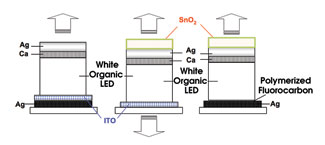
Weaker Microcavities Enable Brighter, Whiter Organic LEDs
Hank Hogan
Consumer display companies have declared white organic LEDs the wave of the future. Combined with a color filter to create red, green or blue and a transistor to switch pixels on and off, top-emitting organic LEDs promise full-color displays that are bright and stable.

The researchers investigated three structures of organic LEDs (left to right): conventional top-emitting, transparent and electrode-modified. Theelectrode-modified design avoids the microcavity effect that causes spectralnarrowing of the output.
But building the emitters upon which the scheme depends has been a challenge. Researchers at National Chiao Tung and National Tsing Hua universities, both in Hsinchu, Taiwan, have demonstrated a fabrication technique that solves this problem.
Top-emitting organic LEDs suffer from a microcavity effect in which the reflective end caps of the devices and their length together allow only certain wavelengths to emerge. As a result, it is difficult to generate broadband white light, explained National Chiao Tung graduate student Shih-Feng Hsu. Hsu worked on the project under the direction of Chin H. Chen, a professor at the university’s Display Institute.
The investigators have modified a conventional top-emitting organic LED structure comprising a white-light organic LED material sandwiched between various thin metal films and sitting atop a substrate. Typically, silver is in both end caps. The film at the anode is thick enough to be reflective, and the one at the cathode is thin enough — 15 nm or so — to be semitransparent. The two form a microcavity, and the light from the organic LED bounces between them, escaping only at certain wavelengths.
In the new device’s geometry, the researchers use a silver anode coated with a polymerized fluorocarbon film and cap the silver on the cathode with an index-matching film of tin oxide. This keeps the anode highly reflective, which is important to luminance efficiency, while diminishing the microcavity effect. Hsu noted that the absence of an indium-tin-oxide layer also shortens the optical length of the device, which further alleviates the microcavity effect.
The top-emitting white organic LEDs built with the new scheme display an efficiency of 9.6 lm/W, several times that of emitters built using the conventional approach. However, Hsu cautioned that direct comparisons are difficult because the output from a standard device has an electroluminescent full width half maximum of 20 nm, while the corresponding figure for the new devices is 136 nm.
The group is working to create a balanced white-light source by adding red emission to the device’s output.
Applied Physics Letters, June 20, 2005, 253508.
Published: September 2005